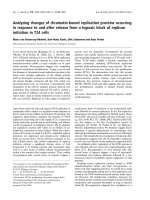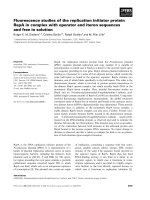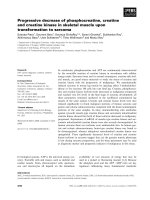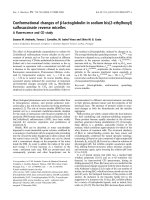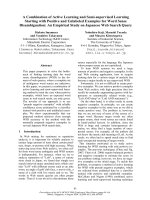Báo cáo khoa học: " Early changes of CD4-positive lymphocytes and NK cells in patients with severe Gram-negative sepsis" ppt
Bạn đang xem bản rút gọn của tài liệu. Xem và tải ngay bản đầy đủ của tài liệu tại đây (212.63 KB, 7 trang )
Open Access
Available online />Page 1 of 7
(page number not for citation purposes)
Vol 10 No 6
Research
Early changes of CD4-positive lymphocytes and NK cells in
patients with severe Gram-negative sepsis
Evangelos J Giamarellos-Bourboulis, Thomas Tsaganos, Ekaterini Spyridaki, Maria Mouktaroudi,
Diamantis Plachouras, Ilia Vaki, Vassiliki Karagianni, Anastasia Antonopoulou, Vassiliki Veloni and
Helen Giamarellou
4th Department of Internal Medicine, University of Athens, Medical School, 1 Rimini Str., Athens 124 62, Greece
Corresponding author: Evangelos J Giamarellos-Bourboulis,
Received: 2 Sep 2006 Revisions requested: 29 Sep 2006 Revisions received: 21 Oct 2006 Accepted: 27 Nov 2006 Published: 27 Nov 2006
Critical Care 2006, 10:R166 (doi:10.1186/cc5111)
This article is online at: />© 2006 Giamarellos-Bourboulis et al.; licensee BioMed Central Ltd.
This is an open access article distributed under the terms of the Creative Commons Attribution License ( />),
which permits unrestricted use, distribution, and reproduction in any medium, provided the original work is properly cited.
Abstract
Introduction Our aim was to define early changes of
lymphocytes and of NK cells in severe sepsis and to correlate
them with serum levels of soluble triggering receptor expressed
on myeloid cells-1 (sTREM-1).
Methods Blood was sampled from 49 patients with proven
highly suspected infection by Gram-negative pathogens, within
12 hours of the advent of severe sepsis, and was also sampled
from six healthy volunteers. White blood cells were targeted with
monoclonal antibodies and were analyzed by flow cytometry.
The concentrations of sTREM-1 were estimated by ELISA.
Results The presence of CD3/CD4 cells was significantly lower
(P < 0.0001) and that of NK cells significantly higher among
patients with sepsis compared with controls (P = 0.011). The
proportions (median ± standard error) of ANNEXIN-V/CD4/
CD3-positive cells, of ANNEXIN-V/CD8/CD3-positive cells and
of ANNEXIN-V/CD14-positive cells of the patient population
were 7.41 ± 2.26%, 7.69 ± 3.42% and 1.96 ± 4.22%,
respectively. Patients with NK cells >20% survived longer
compared with those patients with NK cells ≤20% (P = 0.041),
and patients with sTREM-1 concentrations >180 pg/ml survived
longer compared with those patients with sTREM-1
concentrations ≤180 pg/ml (P = 0.042). A negative correlation
was found between the percentages of ANNEXIN-V/CD4/CD3-
positive cells and of CD3/CD4 cells (r
s
= -0.305, P = 0.049),
and a positive correlation was found between the serum
sTREM-1 concentration and the percentage of NK cells (r
s
=
+0.395, P = 0.014). NK cells isolated from two healthy
volunteers released sTREM-1 upon triggering with endotoxins.
Conclusion Early severe sepsis is characterized by CD4-
lymphopenia and increased NK cells, providing a survival benefit
for the septic patient at percentages >20%. The survival benefit
resulting from elevated NK cells might be connected to elevated
serum levels of sTREM-1.
Introduction
Human studies in patients with sepsis have shown considera-
ble changes in the subpopulations of lymphocytes [1], and
particularly of those lymphocytes participating in adaptive
immunity. These changes involve decreases of T-helper cells
and of B lymphocytes. Data about the exact time point in the
septic cascade where these changes occur are not available,
however, although these data are of extreme importance since
depletion of lymphocytes renders the septic hosts susceptible
to further infectious insults.
Sparse data of either animal or human studies implicate a cru-
cial role of new counterparts of the innate immune system in
the pathogenesis of sepsis. These data comprise NK cells that
are a subpopulation of lymphocytes behaving as cells of the
innate immune system [2], as well as neutrophils and mono-
cytes expressing the triggering receptor expressed on myeloid
cells-1 receptor on their cell membranes in the event of human
sepsis [3]. The soluble form of this receptor, namely soluble
triggering receptor expressed on myeloid cells-1 (sTREM-1),
is proposed to act as an anti-inflammatory mediator and to
contribute to the transition from sepsis to septic shock [4,5].
ELISA = enzyme-linked immunosorbent assay; NK = natural killer; PBS = phosphate-buffered saline; pO
2
/FiO
2
= partial oxygen tension to oxygen
fraction ratio; sTREM-1 = soluble triggering receptor expressed on myeloid cells-1.
Critical Care Vol 10 No 6 Giamarellos-Bourboulis et al.
Page 2 of 7
(page number not for citation purposes)
Based on the latter evidence, the present study investigated
whether changes of lymphocytes and NK cells occur early in
severe sepsis. A cohort of patients with severe sepsis due to
proven or highly suspected infection by Gram-negative bacte-
ria was utilized. The use of this cohort stemmed from the
necessity to study a population as homogeneous as possible
for the type of antigenic stimulus. Changes of subpopulations
of lymphocytes and of NK cells were also correlated to serum
levels of sTREM-1.
Patients and methods
Study design
All patients hospitalized in the 4
th
Department of Internal Med-
icine of the 'ATTIKON' University Hospital of Athens during the
period November 2004 to January 2006 were delegates for
the study. The protocol was approved by the Ethics Commit-
tee of the hospital and written informed consent was provided
by the patients or their relatives.
Inclusion criteria were the concomitant presence of acute
pyelonephritis, acute intra-abdominal infection or nosocomial
pneumonia within the past 36 hours, and signs of severe sep-
sis within the past 12 hours. Exclusion criteria were neutrope-
nia (≤500 neutrophils/mm
3
), HIV infection, oral intake of
corticosteroids at a dose equal to or higher than 1 mg/kg
equivalent prednisone for a period longer than one month, and
administration of drotrecogin alpha prior enrolment.
Diagnosis of acute pyelonephritis was assigned to any patient
with the following symptoms [6]: core temperature >38°C or
<36°C, lumbar tenderness or radiological findings consistent
with acute pyelonephritis, and pyuria defined as >10 white
blood cells/high power field or +3 dipstick of urine for white
cells.
Diagnosis of an intra-abdominal infection was made for any
patient with the following symptoms [7]: core temperature
>38°C or <36°C, white blood cells >12,000/μl, and pain on
palpation or radiological findings consistent with an intra-
abdominal infection.
Nosocomial pneumonia was diagnosed by the following crite-
ria: the presence of symptoms at least 48 hours after hospital
admission, provided that the infection was not under an incu-
bation period prior to admission; a core temperature >38°C or
<36°C; new or persistent consolidation in a lung X-ray scan; a
sputum Gram strain with a predominance of Gram-negatives;
and a modified clinical pulmonary infection score >5. The
modified clinical pulmonary infection score was determined
after individual scoring for each of the following parameters
[8]: core temperature, 36.5–38.4°C = 0 points, 38.5–38.9°C
= 1 point, and ≤36°C or ≥39°C = 2 points; white blood cell
count, 4,000–11,000/μl = 0 points, <4,000 or >11,000/μl =
1 point, and >11,000 points and >10% bands = 2 points;
pO
2
/FiO
2
, ≥240 or the presence of acute respiratory distress
syndrome = 0 points, and <240 in the absence of acute res-
piratory distress syndrome = 2 points; diffuse shadows on
lung X-ray scan = 1 point and localized shadow on lung X-ray
scan = 2 points; and purulent tracheobronchial secretions = 2
points.
Severe sepsis was determined as the acute dysfunction of at
least one organ, indicated by the acute presentation of at least
one of the following [9]: acute respiratory distress syndrome,
defined as any pO
2
/FiO
2
<200; acute renal failure, defined as
the production of <0.5 ml urine/kg body weight per hour for at
least two hours provided that the negative fluid balance of the
patient was corrected; metabolic acidosis, defined as any pH
<7.30 or any base deficit >5 mEq/l and serum lactate at least
more than twice the normal value; acute coagulopathy, defined
as any platelet count <100,000/μl or an International Normal-
ized Ratio (INR) >1.5; and acute cardiovascular failure,
defined as systolic pressure <90 mmHg requiring the admin-
istration of inotropic agents for more than one hour provided
the negative fluid balance of the patient was corrected.
Fifty-three patients were eligible for the study; four of these
patients denied informed consent. A total of 49 patients were
therefore enrolled.
Upon enrolment in the study, 10 ml blood was collected. Five
milliliters were added to flasks for culture, another 3 ml were
collected in an ethylenediamine tetraacetic acid-coated tube
(Becton Dickinson, Cockeysville, MD, USA) for immunophe-
notyping, and the remaining blood was added in a sterile tube.
After centrifugation, the serum was kept at -70°C until
assayed. Flasks with blood were incubated for seven days.
Identification of pathogens was performed by the API20E and
the API20NE systems (bioMérieux, Paris, France). Enrolled
patients were followed-up on a daily basis for a total of 28
days.
Laboratory techniques
Red blood cells were lysed with ammonium chloride 1.0 mM
in the whole-blood sample collected into ethylenediamine
tetraacetic acid-coated tubes. White blood cells were washed
three times with PBS (pH 7.2) (Merck, Darmstadt, Germany);
the cells were subsequently incubated for 15 minutes in the
dark with the monoclonal antibodies anti-CD3 and anti-CD19
and the protein ANNEXIN-V with the fluorocolor fluorescein
isothiocyanate (emission 520 nm; Immunotech, Marseille,
France), and with the monoclonal antibodies anti-CD4, anti-
CD8, anti-CD14 and anti-CD(16+56) with the fluorocolor
phycoerythrin (emission 550 nm; Immunotech) with or without
the monoclonal antibody anti-CD3 with fluorocolor PC5 (emis-
sion 600 nm; Immunotech).
The following combinations were applied: anti-CD3/anti-CD4,
anti-CD3/anti-CD8, anti-CD3/anti-CD(16+56), ANNEXIN-V/
anti-CD4/anti-CD3, ANNEXIN-V/anti-CD8/anti-CD3 and
Available online />Page 3 of 7
(page number not for citation purposes)
ANNEXIN-V/antiCD14. Anti-CD19 was applied singularly.
Cells staining positive for the above antibodies were analyzed
after running through the EPICS XL/MSL flow cytometer
(Beckman Coulter Co., Miami, FL, USA) with gating for lym-
phocytes or monocytes based on their characteristic FS/SS
scattering. NK cells were defined as CD3-negative and
CD(16+56)-positive cells.
Blood was also sampled from six healthy volunteers equally
matched for age with the study population. IgG isotypic-nega-
tive controls with the fluorocolors fluorescein isothiocyanate
and phycoerythrin (Immunotech) were applied before the start
of analysis for each patient.
Estimation of sTREM-1 was performed by a home-made
enzyme immunoassay. The capture antibody of sTREM-1
(R&D Inc., Minneapolis, MN, USA) was diluted to 4,000 ng/ml
and distributed in a 96-well plate at a volume of 0.1 ml/well.
After overnight incubation at 25°C, the wells were thoroughly
washed with a 0.05% solution of Tween in PBS (Merck) (pH
7.2–7.4). Then 0.1 ml standard concentrations of sTREM-1
(15.1–4,000 pg/ml; R&D Inc.) or serum was added to the
wells. After incubation for two hours, the wells were washed
three times and 0.1 ml of one 400 ng/ml dilution of sTREM-1
detection antibody (R&D Inc.) was added per well. The plate
was then incubated for two hours, and attached antibodies
were signaled by streptavidin horseradish peroxidase. The
concentrations of sTREM-1 in each well were estimated by the
optical density detected at 450 nm after addition of one 1:1
solution of H
2
O
2
:tetramethylbenzidine as a substrate (R&D
Inc.). All determinations were performed in duplicate; the inter-
day variation of the assay was 5.23%.
Isolation of NK cells
NK cells were isolated from two healthy volunteers, as already
described [10]. Briefly, heparinized venous blood was layered
over Ficoll Hypaque (Biochrom, Berlin, Germany) and was
centrifuged. The buffy coat was washed three times with PBS
(pH 7.2) (Merck), and was then diluted at a volume of 2 ml in
RPMI 1640 (Biochrom) and incubated with 0.2 ml RosetteSep
NK antibody cocktail (StemCell Technologies, Seattle, WA,
USA) for one hour at room temperature with thorough mixing
every ten minutes. The buffy coats were layered over Ficoll
Hypaque and were centrifuged for 20 minutes at 1,200 × g.
After centrifugation, any cells remaining over Ficoll Hypaque
were collected and washed three times in PBS (pH 7.2).
These cells were then stained with anti-CD3 fluorescein isothi-
ocyanate and anti-CD(16+56) phycoerythrin, and were ana-
lyzed after running through the EPICS XL/MSL flow cytometer
with the application of cells stained with IgG isotypic antibod-
ies as negative controls. The collected cells were CD(16+56)-
positive and CD3-negative at a purity greater than 90%.
NK cells were distributed into two wells of a 12-well plate with
2.4 ml RPMI 1640 enriched with 10% fetal bovine serum (Bio-
chrom). Lipopolysaccharide of Escherichia coli O111: B4
(Sigma, St Louis, MO, USA) was added to the second well at
a concentration of 10 ng/ml. The experiment was run in dupli-
cate for each volunteer. After incubation for 18 hours at 37°C
in 5% CO
2
, the content of each well was collected and centri-
fuged. sTREM-1 was estimated in the supernatants, as
described above.
Statistical analysis
Results are expressed as the median and interquartile range,
but those of cell cultures expressed as the means and stand-
ard deviation. Comparisons between patients and healthy con-
trols were performed by the Mann–Whitney U test. Statistical
correlations were performed after assessment of the nonpara-
metric Spearman coefficient (r
s
).
The time of survival was estimated after Kaplan-Meier analysis;
patients were divided into two groups based on serum levels
of sTREM-1 and on the percentage of NK cells. The patients
were categorized into those with serum sTREM-1 ≤180 pg/ml
and serum sTREM-1 >180 pg/ml, as proposed elsewhere
[11]. After scattering of individual values of NK cells for survi-
vors and nonsurvivors, the patients were also divided into
those with NK ≤20% and NK >20%. Comparisons between
these subgroups for survival were performed by log-rank tests.
Comparisons of qualitative data were performed according to
Fischer's test. P < 0.05 was considered statistically
significant.
Results
Clinical characteristics of the patients enrolled in the study are
presented in Table 1. Subpopulations of lymphocytes of
patients compared with healthy controls are presented in
Table 2. CD3/CD4 cells were significantly lower in early
severe sepsis patients compared with controls (P < 0.0001).
NK cells were significantly higher in early severe sepsis
patients compared with controls (P = 0.011).
The median percentage of ANNEXIN-V/CD4/CD3-positive
cells was 7.41%, with a 25th percentile of 1.70% and a 75th
percentile of 19.81%. The median percentage of ANNEXIN-V/
CD8/CD3-positive cells was 7.69%, with a 25th percentile of
2.13% and a 75th percentile of 17.00%. The median percent-
age of ANNEXIN-V/CD14-positive cells was 1.96, with a 25th
percentile of 0.00% and a 75th percentile of 6.54%.
The survival curves of patients in relation to the percentage of
NK cells are shown in Figure 1. Patients with NK cells >20%
survived longer compared with those patients with NK cells
≤20% (P = 0.041). Twenty-four out of 38 patients with NK
cells ≤20% died (63.2%), compared with three out of 11
patients with NK cells >20% (27.3%, P = 0.046).
Critical Care Vol 10 No 6 Giamarellos-Bourboulis et al.
Page 4 of 7
(page number not for citation purposes)
Table 1
Clinical characteristics of 49 patients with early severe sepsis enrolled in the study
Characteristic Severe sepsis
Age (years) 77.0 ± 11.9
Male/female 28/21
Acute Pathophysiology and Chronic Health Evaluation II score 20.2 ± 9.1
Sequential Organ Failure Assessment score 8.53 ± 3.35
Underlying infection
Acute pyelonephritis 29 (59.2)
Acute intra-abdominal infection 12 (24.5)
Nosocomial pneumonia 9 (18.4)
Bacterial pathogen
Escherichia coli 10 (20.4)
Klebsiella pneumoniae 3 (6.1)
Acinetobacter baumannii 3 (6.1)
Morganella morganii 2 (4.1)
Others 2 (4.1)
Bacteremia 9 (18.4)
Case fatality 27 (55.1)
Data presented as the mean ± standard deviation or as n (%).
Table 2
Subpopulations of lymphocytes of 49 patients with early severe sepsis and six healthy controls
Median 5th percentile 25th percentile 75th percentile 95th percentile P value
CD3/CD4 lymphocytes (%)
Controls 45.83 39.40 42.24 53.74 - <0.0001
Severe sepsis 24.71 2.85 13.97 30.27 44.76
CD3/CD8 lymphocytes (%)
Controls 24.87 14.92 19.89 28.09 - NS
Severe sepsis 20.93 3.09 13.00 30.53 51.39
CD3/CD(16+56) lymphocytes (%)
Controls 4.50 1.77 1.91 7.43 - NS
Severe sepsis 6.10 0.76 3.03 10.75 24.75
CD19 lymphocytes (%)
Controls 8.74 7.76 7.81 11.62 - NS
Severe sepsis 4.70 0.48 2.51 10.09 22.77
CD3(-)/CD(16+56) lymphocytes (NK cells) (%)
Controls 4.12 0.25 1.26 8.94 - 0.011
Severe sepsis 11.32 2.25 7.05 18.25 33.69
NS, not significant.
Available online />Page 5 of 7
(page number not for citation purposes)
The survival curves of patients in relation to serum sTREM-1
levels are shown in Figure 2. Patients with sTREM-1 >180 pg/
ml survived longer compared with those patients with sTREM-
1 ≤180 pg/ml (P = 0.042). Twenty-two out of 33 patients with
sTREM-1 ≤180 pg/ml died (66.7%), compared with five out of
16 patients with sTREM-1 >180 pg/ml (31.3%, P = 0.032).
A negative correlation was found between the percentages of
ANNEXIN-V/CD4/CD3-positive cells and of CD3/CD4 cells
(r
s
= -0.305, P = 0.049). A positive correlation was also found
between serum sTREM-1 and the percentage of NK cells (r
s
=
+0.395, P = 0.014).
The concentrations of sTREM-1 released by NK cells of
healthy volunteers and their modification after triggering by
lipopolysaccharide are shown in Figure 3.
Discussion
The identification of early changes taking place in the clinical
setting of a septic host is of prime importance in order to
understand the underlying pathogenesis. The majority of clini-
cal studies do not provide evidence about the alterations of
the immune responses within a short time frame after occur-
rence of organ failure. The lack of knowledge of early changes
responsible for the transition from one stage of sepsis to
another has been proposed as one reason responsible for the
failure of numerous trials of immunointervention in sepsis [12].
The present study was designed to provide information about
the early changes of adaptive immune responses and of NK
cells occurring within the first 12 hours after advent of severe
sepsis. Moreover, the entire population became septic
because of the same antigenic stimulus – one Gram-negative
pathogen. This was achieved by enrolling patients with infec-
Figure 1
Survival curves of patients relative to the presence of NK cellsSurvival curves of patients relative to the presence of NK cells.
Figure 2
Survival curves of patients relative to serum soluble triggering receptor expressed on myeloid cells-1Survival curves of patients relative to serum soluble triggering receptor
expressed on myeloid cells-1.
Figure 3
Release of soluble triggering receptor expressed on myeloid cells-1 by NK cellsRelease of soluble triggering receptor expressed on myeloid cells-1 by
NK cells.
Critical Care Vol 10 No 6 Giamarellos-Bourboulis et al.
Page 6 of 7
(page number not for citation purposes)
tions clinically thought to be caused by Gram-negative
bacteria or having been proved with a microbiological docu-
mentation of their infection being solely of Gram-negative ori-
gin (Table 1). The need for enrolment of patients with Gram-
negative severe infections derived from the high frequency of
Gram-negative bacteria as pathogens [13]. Findings of the
study were correlated to serum levels of sTREM-1, which is a
novel anti-inflammatory mediator of prime importance for the
transition from severe sepsis to septic shock [4,5].
The results revealed two major early changes in the subpopu-
lations of mononuclear cells of the study population. The first
finding consists of a considerable decrease of CD3/CD4 lym-
phocytes (Figure 1). This depletion of CD4-positive lym-
phocytes resulted from cell apoptosis since the percentage of
total CD3/CD4 cells was negatively correlated to the
percentage of apoptotic CD3/CD4 cells. CD4-lymphopenia
as a consequence of apoptosis is a well-described finding in
septic patients [1,13-15]. The presented median rate of apop-
tosis of 7.41% CD4-positive cells is within the range reported
elsewhere for septic patients [16]. The present study is the
first to report the very early occurrence of CD4-lymphopenia in
severe sepsis. The applied flow cytometric analysis of apopto-
sis did not use propidium iodine staining positive for necrotic
cells. Application of the analysis was difficult due to the appli-
cation of a triple combination of fluorocolors for apoptotic lym-
phocytes, rendering possible the yield of false-positive results
for propidium iodine staining. The reported negative correla-
tion between CD3/CD4 cells and the percentage of
ANNEXIN-V/CD4/CD3 cells allows one, with safety, to trust
the analysis of apoptosis.
Contrary to CD4-positive T lymphocytes, B lymphocytes (that
is, CD19-positive cells) remained unaltered (Figure 2). This
finding probably suggests that B-lymphopenia, described by
others [15], is a phenomenon supervening later in the series of
events of sepsis.
The second major early change in the study population was an
increase of NK cells (Table 2) directly connected to the out-
come of the patients in such a manner that a percentage of NK
cells >20% was connected to survival benefit, as opposed to
patients with NK cells ≤20% (Figure 1). In a former study by
Hotchkiss and colleagues [15], focused on immunophenotyp-
ing of cells of the spleen taken from septic patients postmor-
tem or late after the advent of sepsis, an increase of NK cells
was described; however, the increase failed to reach statisti-
cal significance compared with controls. Our study is the first
statistically confirming an early increase of NK cells in severe
sepsis. Animal studies of experimental infections by strepto-
cocci concluded that triggering of NK cells was accompanied
by rapid progression to death [17,18]. The latter experimental
findings are opposite to the beneficiary effect of NK cells
reported in the present study. A probable explanation might be
that in the present cohort of patients severe sepsis was of
Gram-negative origin, whereas pathogens were Gram-positive
cocci in former animal studies.
An explanation for the protective effect of increased NK cells
for the septic host may be provided by the positive correlation
between the percentage of NK cells and serum sTREM-1 con-
centrations. sTREM-1 is a novel mediator considered to play
an anti-inflammatory role in sepsis [5]. The present study is in
accordance with previous results by other authors connecting
serum levels of sTREM-1 >180 pg/ml with prolonged survival
of the septic host [11] (Figure 2). NK cells have never been
reported to be a reservoir for the production of sTREM-1. In
vitro results with cells of healthy volunteers revealed the
potency of NK cells for the production of sTREM-1 upon trig-
gering with lipopolysaccharide (Figure 3). Moreover, the trig-
gering receptor expressed on myeloid cells-1 has a functional
homology to the NKp44 receptor expressed on cell mem-
branes of NK cells [19]. If NK cells of the septic hosts are a
source for sTREM-1, then their protective role in early severe
sepsis may be explained.
Conclusion
The present study provided evidence for the first time that
early severe sepsis is characterized by CD4-lymphopenia and
an increased presence of NK cells, providing a survival benefit
for the septic patient at percentages >20%. The survival ben-
efit resulting from elevated NK cells may be connected to ele-
vated serum levels of sTREM-1.
Competing interests
The authors declare that they have no competing interests.
Authors' contributions
EJG-B participated in the study design, coordinated the lab
job, analyzed the data and wrote the manuscript. TT partici-
pated in the study design and the estimation of sTREM-1. ES
and VK participated in the immunophenotypic analysis. MM
participated in the follow-up of patients. DP participated in the
enrolment of patients. IV, AA and VV participated in the follow-
up of patients. HG drafted the manuscript.
References
1. Holub M, Kluèkova Z, Beneda B, Hobstová J, Hužička I, Pražák J,
Lobovská A: Changes in lymphocyte subpopulations and
CD3
+
/DR
+
expression in sepsis. Clin Microbiol Infect 2000,
6:657-660.
2. Emoto M, Miyamoto M, Yoshizawa I, Emoto Y, Schaibe UE, Kita E,
Kaufmann SHE: Critical role of NK cells rather than Vα14+NKT
Key messages
• Early severe sepsis is characterized by CD4-lymphope-
nia and an increased presence of NK cells.
• Percentages of NK cells in early severe sepsis >20%
and concentrations of sTREM-1 in serum >180 pg/ml
are accompanied by prolonged survival.
Available online />Page 7 of 7
(page number not for citation purposes)
cells in lipopolysaccharide-induces lethal shock in mice. J
Immunol 2002, 169:1426-1432.
3. Bouchon A, Facchetti F, Welgand MA, Colonna M: TREM-1
amplifies inflammation and is a crucial mediator of septic
shock. Nature 2001, 410:1103-1107.
4. Routsi C, Giamarellos-Bourboulis EJ, Antonopoulou A, Kollias S,
Siasiakou S, Koronaios A, Zakynthinos S, Armaganidis A, Gia-
marellou H, Roussos A: Does soluble triggering receptor
expressed on myeloid cells-1 play any role in the pathogene-
sis of septic shock? Clin Exp Immunol 2005, 142:62-67.
5. Giamarellos-Bourboulis EJ, Zakynthinos S, Baziaka F, Papa-
domichelakis E, Virtzili S, Koutoukas P, Armaganidis A, Giamarel-
lou H, Roussos C: Soluble triggering receptor expressed on
myeloid cells-1 as an antiinflammatory mediator in sepsis.
Intensive Care Med 2006, 32:237-243.
6. Pinson AG, Philbrick JT, Lindbeck GH, Schorling JB: Fever in the
clinical diagnosis of acute pyelonephritis. Am J Emerg Med
1997, 15:148-151.
7. Calandra T, Cohen J, International Sepsis Forum Definition of
Infection in the ICU Consensus Conference: The international
sepsis forum consensus conference on definitions of infection
in the intensive care unit. Crit Care Med 2005, 33:1538-1548.
8. Baughman RP: Diagnosis of ventilator-associated pneumonia.
Curr Opin Crit Care 2003, 9:397-402.
9. Levy M, Fink MP, Marshall JC, Abraham E, Angus D, Cook D,
Cohen J, Opal SM, Vincent JL, Ramsay G: 2001 SCCM/ESICM/
ACCP/ATS/SIS international sepsis definitions conference.
Crit Care Med 2003, 31:1250-1256.
10. Whalen MM, Green SA, Loganathan BG: Brief butyltin exposure
induces irreversible inhibition of the cytotoxic function on
human natural killer cells, in vitro. Environ Res 2002, 88:19-29.
11. Gibot S, Cravoisy A, Kolopp-Sarda MN, Béné MC, Faure G, Bol-
laert PE: Time-course of sTREM (soluble triggering receptor
expressed on myeloid cells)-1, procalcitonin, and C-reactive
protein plasma concentrations during sepsis. Crit Care Med
2005, 33:792-796.
12. Vincent JL, Sun Q, Dubois MJ: Clinical trials of immunomodula-
tory therapies in severe sepsis and septic shock. Clin Infect
Dis
2002, 34:1084-1093.
13. Annane D, Aegerter P, Jars-Guincestre MC, Giudet B: Current
epidemiology of septic shock. The CUB-Réa network. Am J
Resp Crit Care Med 2003, 168:165-172.
14. Hotchkiss RS, Osmon SB, Chang KC, Wagner TH, Coopersmith
CM, Karl IE: Accelerated lymphocyte death in sepsis occurs by
both the death receptor and mitochondrial pathways. J
Immunol 2005, 174:5110-5118.
15. Hotchkiss RS, Tinsley KW, Swanson PE, Schmieg RE Jr, Hui JJ,
Chang KC, Osborne DF, Freeman BD, Cobb JP, Buchman TG, et
al.: Sepsis-induced apoptosis causes progressive profound
depletion of B and CD4
+
T lymphocytes in humans. J Immunol
2001, 166:6952-6963.
16. Le Tulzo Y, Pangault C, Gacoulin A, Guilloux V, Tribut O, Amiot L,
Tattevin P, Thomas R, Fauchet R, Drenou B: Early circulating lym-
phocyte apoptosis in human septic shock is associated with
poor outcome. Shock 2002, 18:487-494.
17. Kerr AR, Kirkham LAS, Kadioglu A, Andrew PW, Garside P,
Thompson H, Mitchell TJ: Identification of a detrimental role for
NK cells in pneumococcal pneumonia and sepsis in immuno-
compromised hosts. Microbes Infect 2005, 7:845-852.
18. Goldmann O, Chhatwal GS, Medina E: Contribution of natural
killer cells to the pathogenesis of septic shock induced by
Streptococcus pyogenes in mice. J Infect Dis 2005,
191:1280-1286.
19. Colonna M, Facchetti F: TREM-1 (triggering receptor expressed
on myeloid cells): a new player in acute inflammatory
responses. J Infect Dis 2003, 187(Suppl 2):S397-S401.




